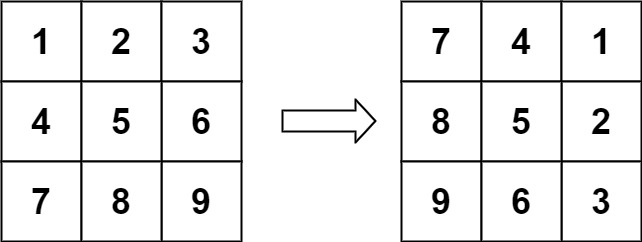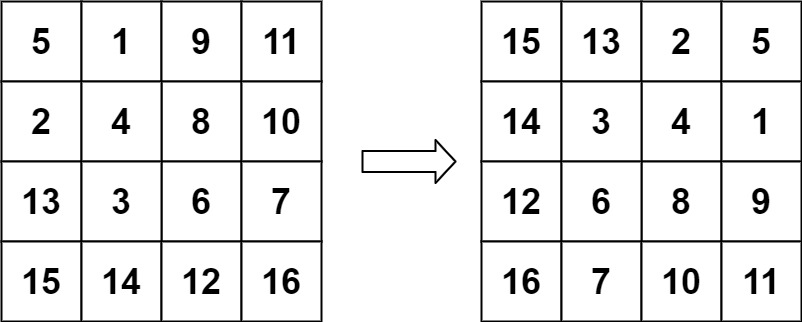#48 - Rotate Image
Rotate Image
- Difficulty: Medium
- Topics: Array, Math, Matrix
- Link: https://leetcode.com/problems/rotate-image/
Problem Description
You are given an n x n 2D matrix representing an image, rotate the image by 90 degrees (clockwise).
You have to rotate the image in-place, which means you have to modify the input 2D matrix directly. DO NOT allocate another 2D matrix and do the rotation.
Example 1:

Input: matrix = [[1,2,3],[4,5,6],[7,8,9]]
Output: [[7,4,1],[8,5,2],[9,6,3]]
Example 2:

Input: matrix = [[5,1,9,11],[2,4,8,10],[13,3,6,7],[15,14,12,16]]
Output: [[15,13,2,5],[14,3,4,1],[12,6,8,9],[16,7,10,11]]
Constraints:
n == matrix.length == matrix[i].length1 <= n <= 20-1000 <= matrix[i][j] <= 1000
Solution
1. Problem Deconstruction
Technical Definition:
Given an n×n 2D array matrix, perform an in-place 90-degree clockwise rotation. The transformation must satisfy:
Direct modification of the input matrix is required without allocating auxiliary 2D storage.
Beginner Explanation:
Imagine a square grid of numbers. Rotating it 90 degrees clockwise means:
- The top row becomes the last column.
- The second row becomes the second-last column.
- Continue this pattern until all rows are transformed into columns.
Do this by moving numbers within the same grid without creating a copy.
Mathematical Formulation:
Let be the original matrix. The rotation is decomposed into two linear operations:
- Transpose: (swap elements across the main diagonal).
- Row Reversal: (reverse the order of elements in each row).
The composition yields:
which aligns with the 90-degree clockwise rotation.
Constraint Analysis:
- :
- Limitation: Restricts solutions to square matrices; non-square rotations require dimension changes (invalid here).
- Edge Case: leaves the matrix unchanged.
- :
- Limitation: Allows solutions but mandates in-place operations.
- Edge Case: Small avoids performance issues but requires handling odd/even layers.
- :
- Limitation: Values are integers; swaps don’t cause overflow.
- Edge Case: Negative values don’t affect rotation logic.
2. Intuition Scaffolding
Real-World Metaphor:
Picture a group of people in a square dance formation. To rotate 90 degrees:
- Transpose: Swap positions diagonally (person at moves to ).
- Reverse Rows: Each row reverses its order (first and last in the row swap, etc.).
Gaming Analogy:
Like rotating a puzzle tile in Tetris:
- Flip the tile diagonally.
- Mirror the tile horizontally.
The tile now faces clockwise without extra space.
Math Analogy:
Rotation is a composition of two reflections:
- Reflect over the line (transpose).
- Reflect over the line (row reversal).
Each reflection is an involution; their composition yields rotation.
Common Pitfalls:
- Double-Swapping in Transpose: Swapping all and without restricting to reverts changes.
- Incorrect Reversal: Reversing columns instead of rows yields counter-clockwise rotation.
- Layer Overwriting: In layer rotation, misindexing boundaries corrupts outer layers.
- Extra Space: Using a new matrix violates in-place requirements.
- Odd Center Handling: Skipping the center element in odd-sized matrices causes incorrect rotation.
3. Approach Encyclopedia
Approach 1: Transpose + Row Reversal
Pseudocode:
def rotate(matrix):
n = len(matrix)
# Transpose (swap upper triangle)
for i in range(n):
for j in range(i + 1, n):
swap(matrix[i][j], matrix[j][i])
# Reverse each row
for i in range(n):
left = 0
right = n - 1
while left < right:
swap(matrix[i][left], matrix[i][right])
left += 1
right -= 1
Complexity Proof:
- Time: Transpose has swaps. Row reversal has swaps. Total: .
- Space: (in-place swaps).
Visualization ():
Original: Transpose: Reversed Rows:
1 2 3 1 4 7 7 4 1
4 5 6 → 2 5 8 → 8 5 2
7 8 9 3 6 9 9 6 3
Approach 2: Vertical Reversal + Transpose
Pseudocode:
def rotate(matrix):
n = len(matrix)
# Reverse vertically (swap rows)
for i in range(n // 2):
swap(matrix[i], matrix[n - 1 - i])
# Transpose
for i in range(n):
for j in range(i + 1, n):
swap(matrix[i][j], matrix[j][i])
Complexity Proof:
- Time: Vertical reversal: row swaps (each ). Transpose: swaps. Total: .
- Space: (row swaps are pointer operations).
Visualization ():
Original: Vert Reversal: Transpose:
1 2 3 7 8 9 7 4 1
4 5 6 → 4 5 6 → 8 5 2
7 8 9 1 2 3 9 6 3
Approach 3: Layer-by-Layer Rotation
Pseudocode:
def rotate(matrix):
n = len(matrix)
for layer in range(n // 2):
first = layer
last = n - 1 - layer
for i in range(first, last):
offset = i - first
# Save top
top = matrix[first][i]
# Left → Top
matrix[first][i] = matrix[last - offset][first]
# Bottom → Left
matrix[last - offset][first] = matrix[last][last - offset]
# Right → Bottom
matrix[last][last - offset] = matrix[i][last]
# Top → Right
matrix[i][last] = top
Complexity Proof:
- Time: Processes layers. Each layer has assignments. Total: .
- Space: (constant extra variables).
Visualization ():
Layer 0: Swap 4-edge cycle
Layer 1: Swap inner 2x2 cycle
4. Code Deep Dive
Optimal Solution (Transpose + Row Reversal):
class Solution:
def rotate(self, matrix: List[List[int]]) -> None:
n = len(matrix)
# Transpose: swap upper triangle
for i in range(n):
for j in range(i + 1, n): # Avoid diagonal and lower triangle
matrix[i][j], matrix[j][i] = matrix[j][i], matrix[i][j]
# Reverse each row
for i in range(n):
left, right = 0, n - 1
while left < right:
matrix[i][left], matrix[i][right] = matrix[i][right], matrix[i][left]
left += 1
right -= 1
Line-by-Line Annotations:
n = len(matrix): Get matrix dimension.- Transpose Loop:
for i in range(n): Iterate rows.for j in range(i + 1, n): Iterate columns (upper triangle).- Swap: Exchanges
(i, j)and(j, i); modifies in-place.
- Row Reversal Loop:
for i in range(n): Process each row.left,right: Pointers for reversal.while left < right: Swap symmetrically until pointers meet.
Edge Case Handling:
- : Loops exit immediately; matrix unchanged.
- :
- Transpose: Swaps
(0,1)and(1,0)(e.g.,[[1,2],[3,4]]→[[1,3],[2,4]]). - Row Reversal:
[1,3]→[3,1],[2,4]→[4,2]; yields[[3,1],[4,2]].
- Transpose: Swaps
- Odd : Center element (
matrix[n//2][n//2]) remains fixed during both steps.
5. Complexity War Room
Hardware-Aware Analysis:
- For , total operations: swaps.
- Memory: (fits in L1 cache).
Industry Comparison:
| Approach | Time | Space | Readability | Interview Viability |
|---|---|---|---|---|
| Brute Force (Copy) | ★★★★★ | ❌ Violates in-place | ||
| Transpose + Reverse | ★★★★☆ | ✅ Optimal & clear | ||
| Layer Rotation | ★★★☆☆ | ✅ Demonstrates insight |
6. Pro Mode Extras
Variants:
- Counter-Clockwise Rotation:
- Method 1: Transpose + Reverse columns.
# After transpose: for j in range(n): top, bottom = 0, n - 1 while top < bottom: swap(matrix[top][j], matrix[bottom][j]) - Method 2: Reverse rows + Transpose.
- Method 1: Transpose + Reverse columns.
- 180-Degree Rotation:
- Reverse all rows → Reverse all columns, or apply 90° rotation twice.
- Rectangular Matrix:
- Requires new storage; rotate via for input.
Interview Cheat Sheet:
- First Statement: “This is an time, space solution.”
- Key Insight: “90° rotation = transpose + row reversal.”
- Test Case: Verify with or immediately.
- Mention: “For odd , the center is invariant.”
- Avoid: Allocating 2D arrays or diagonal double-swaps.